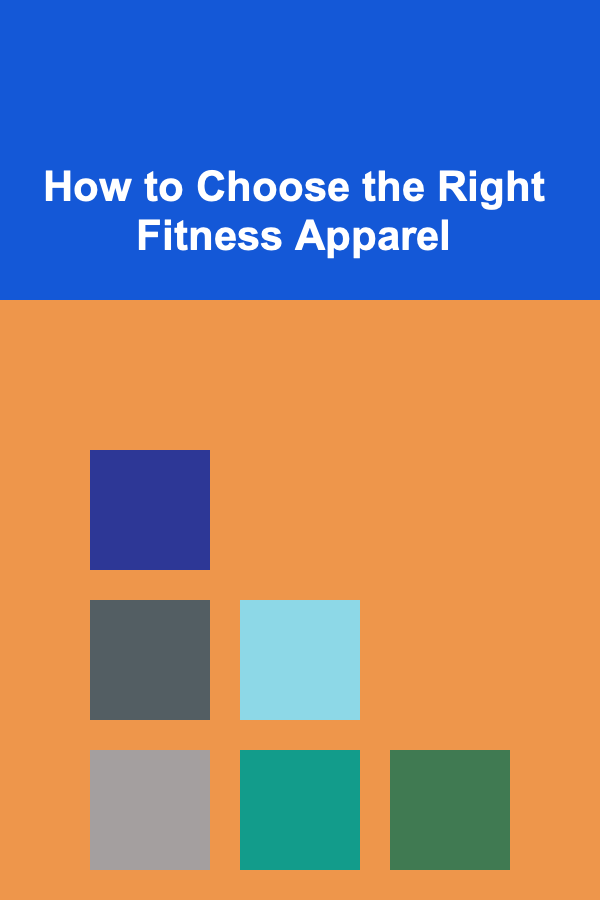
How to Choose the Right Fitness Apparel
ebook include PDF & Audio bundle (Micro Guide)
$12.99$5.99
Limited Time Offer! Order within the next:

Fitness apparel has become an essential part of the modern fitness journey. Whether you are hitting the gym, going for a run, attending a yoga class, or participating in any other physical activity, the clothes you wear play a crucial role in your performance, comfort, and overall experience. The right fitness apparel can enhance your workouts, prevent injuries, and boost your motivation. On the other hand, wearing improper or ill-fitting clothes can be distracting, uncomfortable, and even lead to unnecessary discomfort during exercise.
In this comprehensive guide, we will explore the factors to consider when choosing the right fitness apparel for different types of workouts, what materials to look for, the importance of fit, and how to balance style with functionality.
Understanding the Role of Fitness Apparel
Fitness apparel is designed not just to look good but also to support the body during physical activity. When choosing workout clothes, it's essential to understand the specific roles these clothes play:
- Breathability: Fitness apparel should allow the skin to breathe, preventing excess moisture build-up that can lead to discomfort or skin irritation.
- Comfort: Clothes need to fit well without being too tight or too loose. You should feel unrestricted in your movement.
- Support: Some exercises require more support than others (e.g., running versus yoga), so different types of fitness apparel offer varying levels of support for the body, such as sports bras or compression gear.
- Durability: Since fitness apparel goes through rigorous movement, sweat, and even harsh environments, durability is a key factor in choosing clothes that will last through repeated use.
Now, let's look at the key aspects you should consider when selecting fitness apparel.
Consider the Type of Workout
The type of exercise or workout you are doing greatly influences the kind of apparel you should choose. Not all activities require the same type of clothing. For instance, a yoga session calls for different gear compared to high-intensity interval training (HIIT) or weightlifting.
2.1 Running or Cardio
For running or cardio-based activities, breathability and moisture-wicking properties are key considerations. You will likely sweat a lot, so the clothes need to manage moisture efficiently. Here are some features to look for in running apparel:
- Lightweight materials: Choose lightweight fabrics such as polyester or nylon that won't weigh you down and can dry quickly.
- Breathable fabrics: Look for fabrics that allow air to flow through, like mesh panels or fabrics specifically designed to wick moisture away from your skin.
- Proper fit: Running clothes should fit snugly to avoid chafing. However, avoid clothes that are too tight, which could restrict movement. Compression tights are great for runners, as they improve circulation and reduce fatigue.
- Reflective elements: If you run outdoors, especially in low-light conditions, opt for apparel with reflective strips or designs for visibility.
2.2 Strength Training or Weightlifting
When lifting weights, you need clothing that offers comfort, flexibility, and durability. In particular, your clothes should allow you to move freely while also being durable enough to withstand the stresses of heavy lifting. Consider the following:
- Stretchy, supportive fabrics: Materials like spandex or Lycra are great for strength training because they offer flexibility and allow for a full range of motion.
- Breathable fabrics: Look for fabrics that keep you cool as you lift. High-performance synthetic fibers like polyester can be excellent for moisture-wicking.
- No loose fabrics: Avoid clothing with loose fabric or accessories (e.g., baggy shorts) that can interfere with your movements or get caught in equipment.
- Compression gear: Compression apparel helps to support the muscles, reducing the risk of injury and improving circulation.
2.3 Yoga and Pilates
Yoga and Pilates require movement, flexibility, and balance, which means your clothing must stretch and bend without restricting you. The focus is on comfort and support.
- Stretch fabrics: Opt for fabrics like cotton, spandex, or blends of these materials, as they stretch and allow freedom of movement.
- Softness: Comfort is crucial in activities like yoga, so choose fabrics that feel soft on the skin to avoid irritation during long sessions.
- Fitted clothing: While you don't want clothes that are too tight, fitted clothing allows instructors to see your body alignment during practice, which can be important for form correction.
- Breathability: Breathable fabrics ensure that sweat doesn't stay trapped, helping you stay cool and comfortable during your practice.
2.4 HIIT and CrossFit
High-intensity interval training (HIIT) and CrossFit workouts involve a lot of explosive movements, jumps, and heavy lifting. Your clothes should be able to handle the high impact while providing freedom of movement.
- Flexible and durable fabrics: Look for materials like nylon or spandex that can stretch and adapt to rapid movements without tearing.
- Moisture-wicking and breathable: Because of the intensity of these workouts, moisture-wicking fabrics will keep you cool and dry throughout your session.
- Good fit and support: Your clothes should fit snugly but allow room for explosive movements. Avoid loose clothing that might get in the way.
Selecting the Right Materials
The material your fitness apparel is made from is one of the most important factors to consider. Different fabrics serve different purposes and have varying levels of performance. Here's a breakdown of some popular fabrics in fitness apparel:
3.1 Synthetic Fabrics
- Polyester: A popular choice for fitness apparel, polyester is durable, lightweight, and moisture-wicking. It dries quickly and helps keep you cool during your workout.
- Nylon: Nylon is another moisture-wicking fabric that is incredibly strong and resistant to wear and tear. It is commonly used in running and cycling apparel.
- Spandex/Lycra/Elastane: These fabrics offer stretch, allowing for maximum flexibility and movement. They are commonly used in yoga pants, compression gear, and fitted workout wear.
- Polypropylene: This synthetic material is known for its moisture-wicking ability and is often used in base layers or gear for extreme conditions.
3.2 Natural Fabrics
- Cotton: While cotton is soft and comfortable, it does not wick moisture as effectively as synthetic materials. It can absorb sweat, making it a poor choice for high-intensity workouts. However, it's fine for low-intensity activities like yoga or casual walks.
- Wool: Merino wool is moisture-wicking and temperature-regulating, making it a great option for outdoor activities or colder climates. It's less common in general fitness apparel but is seen in running gear, especially for winter sports.
3.3 Hybrid Fabrics
Some fitness apparel blends natural and synthetic fibers to maximize comfort, breathability, and moisture-wicking properties. These blends offer the best of both worlds, combining durability with softness.
Fit and Comfort
Finding the right fit is critical to ensuring comfort during your workout. Clothes that are too tight can restrict movement and cause discomfort, while those that are too loose can lead to chafing and may not provide adequate support.
- Compression gear: Compression clothing has become a popular choice for athletes as it provides support and improves blood circulation during intense physical activity. However, it should never be overly tight and should allow for natural movement.
- Tops and bottoms: For tops, consider a snug fit that doesn't ride up or shift too much during exercise. Bottoms, like leggings or shorts, should fit comfortably at the waist and allow freedom of movement for leg exercises.
- Sports bras: For women, selecting the right sports bra is critical. Choose a sports bra that fits securely and provides adequate support, particularly for high-impact activities like running or jumping. Adjustable straps and a wide band can help improve comfort and fit.
Style and Personal Preference
While performance is crucial, fitness apparel has also become a fashion statement. Many fitness brands now offer stylish and trendy workout wear that looks great both in and out of the gym. Here are some considerations for balancing style with functionality:
- Personal style: Choose workout clothes that make you feel good and motivated. When you look good, you feel good, and this can positively impact your performance.
- Color and design: Bright colors and fun designs can help motivate you and make your workout more enjoyable. However, keep in mind that some people prefer neutral tones and simple designs for a more classic look.
- Versatility: Many fitness apparel brands design pieces that can transition easily from the gym to casual wear. If you're someone who likes to go straight from the gym to run errands, look for clothes that are both functional and fashionable.
Budget Considerations
Fitness apparel can range from budget-friendly to high-end. While it's tempting to splurge on premium brands, you don't necessarily need to spend a lot of money to get quality gear. Here are a few tips for managing your fitness apparel budget:
- Invest in key pieces: Some items, like good-quality shoes or sports bras, are worth investing in since they directly impact performance and comfort. However, you can save on other items like shorts or T-shirts.
- Look for sales: Many fitness apparel brands offer seasonal sales or discounts on older collections. Keep an eye out for these opportunities to get high-quality apparel at a lower price.
Sustainability
With increasing awareness of environmental issues, many fitness apparel brands are now focusing on sustainability. Choosing eco-friendly brands and materials is an excellent way to support the environment while staying active. Look for brands that use recycled materials, sustainable production methods, and offer long-lasting apparel to reduce waste.
Conclusion
Choosing the right fitness apparel is essential for comfort, performance, and motivation. Whether you're running, lifting weights, practicing yoga, or doing HIIT, there is a wide range of options to suit every activity. Focus on the type of workout, the materials, the fit, and personal style preferences to make sure you're getting the most out of your fitness apparel. Prioritize functionality, but don't forget to have fun with it!

How to Build a Data Analysis Checklist for Setting Hypotheses and Testing
Read More
How to Organize Travel Outfits to Save Space
Read More
How to Refresh My Home's Curb Appeal with Effective Staging Tips
Read More
How to Track Customer Journeys Across Your Campaigns: An Actionable Guide
Read More
How to Use Lighting to Add Drama and Depth to Your Living Room
Read More
Choosing the Right Broom and Dustpan for Different Surfaces: A Comprehensive Guide
Read MoreOther Products

How to Build a Data Analysis Checklist for Setting Hypotheses and Testing
Read More
How to Organize Travel Outfits to Save Space
Read More
How to Refresh My Home's Curb Appeal with Effective Staging Tips
Read More
How to Track Customer Journeys Across Your Campaigns: An Actionable Guide
Read More
How to Use Lighting to Add Drama and Depth to Your Living Room
Read More